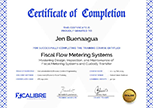| Date | Venue | Fee | |
|---|---|---|---|
| 13 Apr - 17 Apr 2026 | Dubai – UAE | $ 5,950 | Register Now |
| 15 Jun - 19 Jun 2026 | London - UK | $ 5,950 | Register Now |
| 31 Aug - 04 Sep 2026 | London - UK | $ 5,950 | Register Now |
| 09 Nov - 13 Nov 2026 | Dubai – UAE | $ 5,950 | Register Now |
About the Course
Effective asset management has become increasingly crucial for organisations that manage public and private assets. The need to maintain, optimise, and extend the life of infrastructure assets while balancing costs and ensuring compliance with international standards has never been more critical. The ISO 55000 series, a global standard for asset management, provides a comprehensive framework that helps organisations achieve these objectives by integrating asset management into their overall strategy. As organisations face growing pressure to deliver higher performance at lower costs, understanding and implementing these standards can lead to significant long-term benefits.
The Infrastructure Asset Management & ISO 55000 Series training course is designed to equip professionals with the necessary knowledge and skills to effectively manage infrastructure assets in alignment with the ISO 55000 series standards. Delegates will gain a deep understanding of asset management principles and practices, focusing on aligning asset management strategies with organisational goals. By mastering the techniques and methodologies, they will be better prepared to make informed decisions that enhance asset performance, reduce risks, and ensure compliance with regulatory requirements.
Delegates will use a structured approach to building and implementing an effective asset management system. It emphasizes the importance of a strategic and systematic approach to managing assets, ensuring that organisations can meet current and future challenges while optimising their infrastructure investments. By the end of the training program, they will be well-prepared to lead asset management initiatives within their organisations, driving improvements in efficiency, reliability, and overall asset value, which is essential for those seeking to advance their expertise in infrastructure asset management and contribute to their organisation's long-term success.
Core Objectives
By the end of the training course, delegates will be able to:
- Identify the fundamental principles and key components of infrastructure asset management as outlined in the ISO 55000 series
- Explain the importance of aligning asset management strategies with organisational goals and how this alignment supports long-term infrastructure performance
- Demonstrate the ability to implement basic asset management processes
- Evaluate the current state of an asset management system within an organisation
- Assess the effectiveness of various risk-based maintenance strategies and decision-making frameworks to optimise the management of infrastructure assets
- Develop a comprehensive asset management plan that aligns with organisational strategy, incorporating risk management, maintenance optimisation, and long-term planning
- Integrate knowledge of asset management roles and responsibilities into a cohesive team structure
Training Approach
This training course employs a blended learning approach, combining interactive lectures with hands-on workshops to ensure a deep understanding of the subject matter. Delegates will engage in group discussions and problem-solving exercises to apply concepts in real-world scenarios. The methodology emphasizes practical application, developing actionable strategies to implement immediately in their organisations.
The Attendees
This training course is designed for professionals in the energy and utility sectors, including those managing regulatory compliance, policy development, and operational oversight.
Likewise, it will be valuable to the professionals but not limited to the following:
- Infrastructure Managers
- Asset Management Professionals
- Maintenance Engineers
- Operations Managers
- Facility Managers
- Risk Managers
- Project Managers
- Strategic Planners
- Regulatory Compliance Officers
- Public Sector Officials
- Utility Managers
- Engineers in the Public Infrastructure Sector
- Quality Assurance Managers
- Procurement Officers
- Supply Chain Managers
- Finance Managers
- Health, Safety, and Environmental (HSE) Managers
- Urban Planners
Daily Discussion
DAY ONE: KEY CONCEPTS IN ASSET MANAGEMENT
- What is Asset Management?
- Importance of Asset Management for Public Infrastructure
- Basic Principles of Asset Management
- Reference Models in Asset Management
- Overview of ISO 55000 Series
- Asset Management Roles: Asset Owner, Asset Manager, Service Provider
- Building the Asset Management System for Public Infrastructure Assets
- Understanding the Asset Lifecycle
- Key Performance Indicators (KPIs) for Asset Management
DAY TWO: ASSET MANAGEMENT INTEGRATION WITH ORGANISATIONAL GOALS
- Stakeholder Needs and Demand Analysis
- Defining Required Service Levels – Current and Future
- The Concept of the Line of Sight in Asset Management
- Developing the Asset Management Policy
- Strategic Asset Management Plan (SAMP)
- Underlying Asset Management Plans (AMP)
- Aligning Asset Management with Organisational Goals
- Communication Strategies for Alignment
- Monitoring and Reporting on Strategic Alignment
DAY THREE: UNDERSTANDING THE PRESENT CONDITION OF ASSETS AND MANAGEMENT SYSTEMS
- Asset Register: Location and Inventory of Assets
- Identifying the Condition and Useful Life of Assets
- Valuation of Asset Portfolio
- End-of-Life Framework and Strategies
- Gap Analysis of the Current Asset Management System
- Developing a Roadmap for Asset Management
- Integration with SAMP and AMP
- Data Management in Asset Information Systems
DAY FOUR: BUILDING RISK-CENTRIC MAINTENANCE PLANS
- Understanding Failure Behavior of Assets
- Risk Assessment: Identifying Critical Failures
- Implementing a Risk-Based Maintenance Approach
- Failure Modes, Effects, and Criticality Analysis (FMECA)
- Developing Maintenance Reference Plans
- Workflow Integration for Maintenance Activities
- Optimisation of Maintenance Strategy and Role of Maintenance Engineer
- Cost-Benefit Analysis of Maintenance Strategies
- Technology and Tools for Risk-Based Maintenance
DAY FIVE: DECISION-MAKING AND BUILDING YOUR ASSET MANAGEMENT TEAM
- Frameworks for Decision-Making in Asset Management
- Preparing for Informed Decision-Making – Asset Management Triangle
- Developing Scenarios and Business Case Criteria
- Integration with Planning and Control Cycle
- Long-Term Investment and Maintenance Planning
- Building and Structuring Effective Asset Management Teams
- Defining Roles, Competencies, and Implementation Strategies
- Stakeholder Engagement in Decision-Making
Certificate Awarded
Upon successful completion of this training course, participants will be awarded a Certificate of Completion from XCalibre Training Centre, acknowledging their accomplishment. This certificate serves as a testament to their dedication to developing their skills and advancing their expertise in their respective fields.


